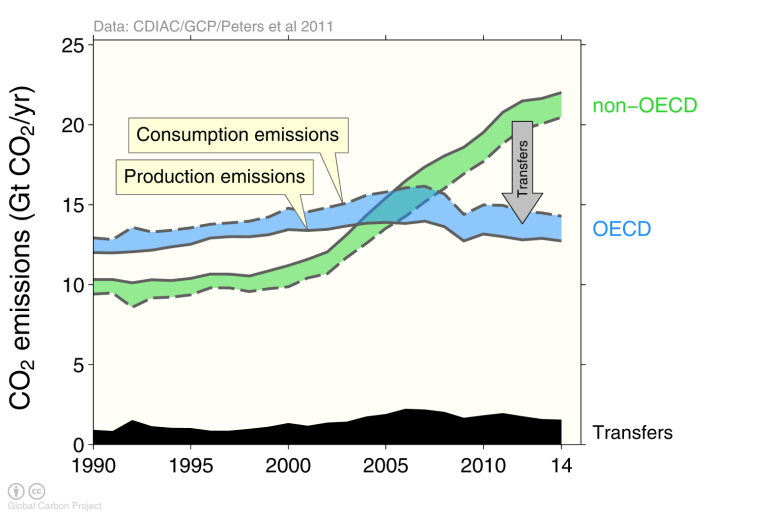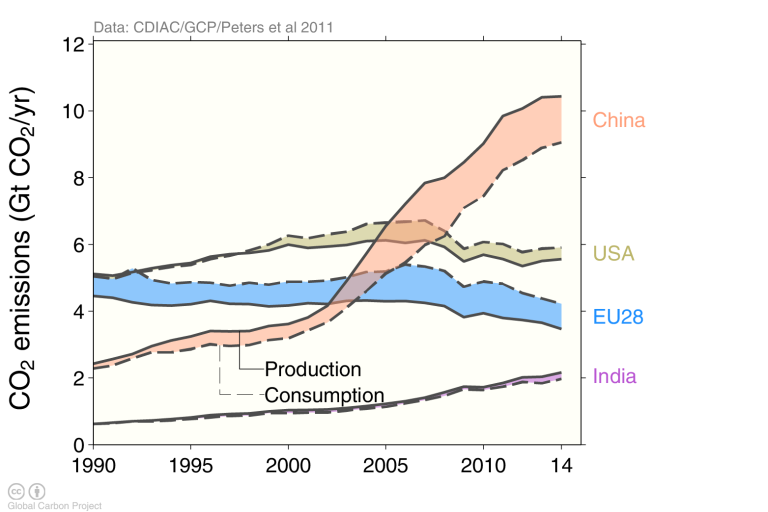Global Environmental Footprints
COMMENTARY: In rich countries, the environmental footprint is growing while domestic environmental pressures are declining, most studies find. Should policy focus on consumption instead of production?
In an increasingly globalised world there has been growing interest in allocating environmental flows to final consumption, leading to an ‘environmental footprint’.
‘Environmental flows’ (emissions and resource use) are typically allocated to national territories since that is where national governments have jurisdiction both to monitor and to apply policies. This allocation typically leads to ‘production-based policies’, as environmental flows generally – but not always – occur at the location where goods and services are produced.
In an increasingly globalised world there has been growing interest in allocating environmental flows to final consumption, leading to an ‘environmental footprint’. An environmental footprint can be conceptualised as the national territorial flows, plus flows occurring in other countries related to the production of imports, minus domestic flows related to the production of exports.
For most environmental flows, developed countries have larger environmental footprints than their national territorial flows, making developed countries ‘net importers’ of environmental flows. This ‘net import’ has tended to increase ever since estimation of environmental footprints started two decades ago.
Most studies have focused on carbon dioxide emissions, due to its relevance to climate policy and growing concerns about carbon leakage and competitiveness concerns. For carbon dioxide, developed countries (OECD) have seen consumption emissions grow, while production emissions have developed. The opposite is true for developing countries (non-OECD). Though, interestingly, since the Global Financial Crisis the gap between the production and consumption emissions has stabilised, or even declined. The growth in exported emissions from China largely explained the growth in the 2000’s, and China is largely behind the recent stabilisation.

Non-OECD countries have had rapid emissions growth, a part of which is to produce products which are exported to OECD counties. If an adjustment is made for these net exports (emission transfers), OECD countries are allocated more emissions, meaning they consume more than they produce in terms of emissions. Source: Adapted from the Global Carbon Project.
New policies needed?
The ‘net import’ is a result of developed countries increasing their consumption while other countries increase their production and emissions. It has been suggested that this reduces the effectiveness of environmental policies, and that policies therefore should address the environmental footprint rather than just domestic flows.
While there is a significant research on methodologies to estimate environmental footprints, and decompose the resulting estimates, there is very little research on policy applications. Most policy research has been on greenhouse gas emissions and using trade measures (e.g., border carbon adjustments) to shift climate policy to a footprint perspective.
Environmental footprints improve our understanding of the role of consumption and international trade on environmental problems. This gives greater understanding to consumers and policy makers, and disaggregated time series of environmental footprints provide an important baseline for potential future policy applications.
Policy applications of environmental footprints are limited by estimation and interpretation uncertainty, and the lack of a clear motivation for policy makers to pursue policies based on environment footprints.
Global Environmental Footprints from Glen Peters
Summary of the key messages
The definitions of different ‘environmental footprints’ vary, and the definitions are not necessarily tailored for policy relevance.
There are many different methods to estimate environmental footprints, but we recommend ‘multi-regional input-output analysis’ for national environmental footprints, as it is comprehensive, consistent with the ‘System of National Accounts’, and links to the final consumption of goods and services.
The data requirements are immense and complex, but several groups have constructed global data sets independently, and often these data sets are available publicly.
Reliability and uncertainty remain persistent issues, despite greater understanding in recent years, and this limits policy applications.
Environmental footprints have been primarily driven by research interests, and a focus on policy implementation may require different levels of aggregation and analytical focus.
It is important to monitor, report, and verify key environmental footprints to understand the role of consumption in driving environmental problems, tracking progress, informing policy, and developing baselines and expertise for potential policy implementation.
For policy applications of national environmental footprints, it is important to delineate what policies may be additional compared to a conventional territorial or production approach.
Carbon footprints have the most obvious policy applicability compared to other footprints, but it is unclear whether the potential gains offset the potentially large ‘transaction costs’.
Many environmental footprints pertain to environmental problems that are best dealt with locally (land and water use) and, apart from providing additional understanding, the policy utility of the corresponding environmental footprints may be limited relative to the standard territorial approach.

Generally, but not always, developed countries are net importers of emissions (e.g., USA and EU28), while developing countries are net exports (e.g., China and India). China has been the main cause of increasing emission transfers in the last decade. Source: Global Carbon Project.
The full report, “Global environmental footprints: A guide to estimating, interpreting and using consumption-based accounts of resource use and environmental impacts”, was funded by the Nordic Council of Ministers, Environment and Economy Group. The report focuses on carbon, land, water, and material footprints.
